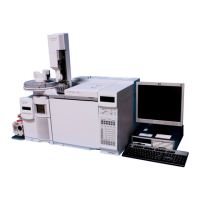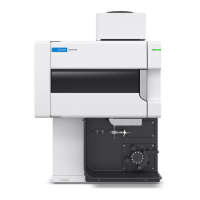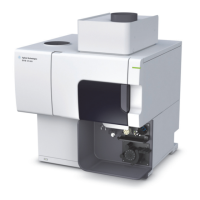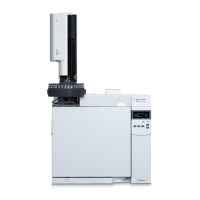Chemical Ionization Theory A
5975 Series MSD Operation Manual for MassHunter 183
Hydride abstraction
In the formation of reagent ions, various reactant ions can be formed that have
high hydride-ion (H
–
) affinities. If the hydride-ion affinity of a reactant ion is
higher than the hydride-ion affinity of the ion formed by the analyte's loss of
H
–
, then the thermodynamics are favorable for this chemical ionization
process. Examples include the hydride abstraction of alkanes in methane
chemical ionization. In methane CI, both CH
5
+
and C
2
H
5
+
are capable of
hydride abstraction. These species have large hydride-ion affinities, which
results in the loss of H
–
for long-chain alkanes, according to the general
reaction
R
+
+ M [M–H]
+
+ RH
For methane, R
+
is CH
5
+
and C
2
H
5
+
, and M is a long-chain alkane. In the case
of CH
5
+
, the reaction proceeds to form [M–H]
+
+ CH
4
+ H
2
. The spectra
resulting from hydride abstraction will show an M–1 m/z peak resulting from
the loss of H
–
. This reaction is exothermic so fragmentation of the [M–H]
+
ion
is often observed.
Often, both hydride-abstraction and proton-transfer ionization can be evident
in the sample spectrum. One example is the methane CI spectrum of
long-chain methyl esters, where both hydride abstraction from the
hydrocarbon chain and proton transfer to the ester function occur. In the
methane PCI spectrum of methyl stearate, for example, the MH
+
peak at
m/z 299 is created by proton transfer and the [M–1]
+
peak at m/z 297 is
created by hydride abstraction.
Addition
For many analytes, proton-transfer and hydride-abstraction chemical
ionization reactions are not thermodynamically favorable. In these cases,
reagent gas ions are often reactive enough to combine with the analyte
molecules by condensation or association (addition reactions). The resulting
ions are called adduct ions. Adduct ions are observed in methane chemical
ionization by the presence of [M+C
2
H
5
]
+
and [M+C
3
H
5
]
+
ions, which result in
M+29 and M+41 m/z mass peaks.
Addition reactions are particularly important in ammonia CI. Because the
NH
3
has a high proton affinity, few organic compounds will undergo proton
transfer with ammonia reagent gas. In ammonia CI, a series of ion-molecule
reactions takes place, resulting in the formation of NH
4
+
, [NH
4
NH
3
]
+
, and
[NH
4
(NH
3
)
2
]
+
. In particular, the ammonium ion, NH
4
+
, will give rise to an

